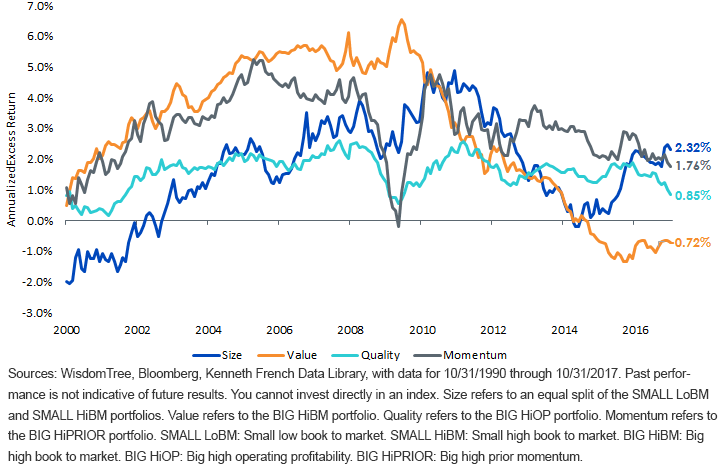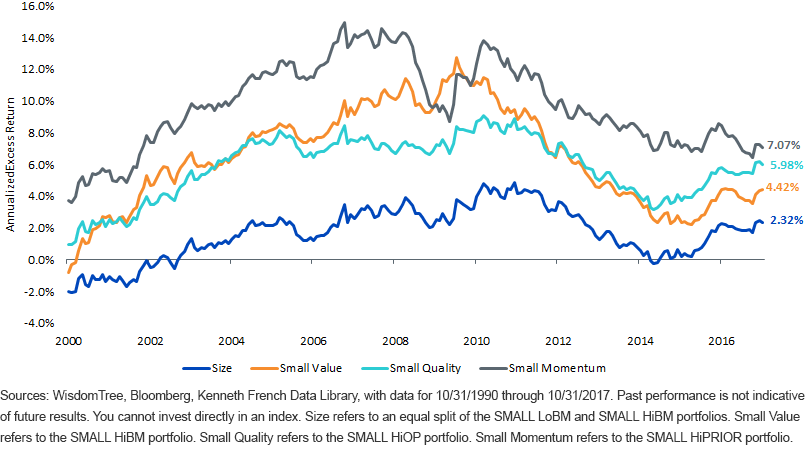Do Factors Work In International Equities?
A few weeks ago, we looked at the current state of affairs in smart beta factors in the U.S. markets. With flows into U.S. smart beta stock ETFs in recent years, we found that there was a reduced, but not eliminated, effectiveness with a factor-based approach.
Many investors see international equity markets as generally less efficient than U.S. markets, and as such, we wanted to see if factors have a greater propensity to outperform the broad market outside the U.S.
Rolling 10-Year Annualized Excess Returns vs. MSCI EAFE

International Factors: Larger Excess Performance than U.S. Factors
Over the last 10 years, the size, quality and momentum factors have generated strong excess returns compared to the MSCI EAFE Index. Echoing what we saw in the U.S., the value factor is in the midst of its worst relative performance in its (albeit shorter) history.
An important takeaway we found was that for the international size, value and momentum factors, their excess performance over the last 10 years was greater than what we found from their U.S. counterparts (and the international quality factor, although having slightly less robust outperformance than the U.S. quality factor, still managed to outperform the MSCI EAFE Index on every rolling 10-year time frame).
To us, this has massive implications: that a factor-based approach may be even more effective at outperforming cap-weighted indexes in international markets than in U.S. markets.
Size on the Rise
Interestingly, the size factor has seen its excess performance spike upward in recent years. When we review investors’ portfolios, we typically see many who already allocate to U.S. small caps. However, it is far less frequent that we find international small caps, from either developed or emerging markets. Given how much value small caps can add to a portfolio, we fully advocate for their inclusion where appropriate. That said, when it comes to small caps, we always prefer a discretionary approach.
Not All Small Caps Will Suffice
AQR wrote an influential paper in 2015 about the need to take an additional step beyond market cap when analyzing and investing in small caps.1 While many small companies can be lower in quality, when those are removed from the equation, the size factor becomes much more robust in efficacy. The paper focused on U.S. markets, so we wanted to see if the additional layer of scrutiny held up in international markets as well.
Rolling 10-Year Annualized Excess Return vs. MSCI EAFE

Size Is Good, But Size and Something Else Is Better
On every single rolling time frame, the combination of size and one additional factor outperformed the standalone size factor. Further, outside of a three-month period in 2000, each of the “size-plus” portfolios outperformed the broad MSCI EAFE Index as well.
Therefore, we can conclude that investors allocating to international small caps may outperform the market—but those allocating within small caps may do even better.
Dividend Weighting in Small Caps: 3 Factors in 1
Launched in 2006, the WisdomTree International SmallCap Dividend Fund (DLS) takes our dividend-weighted approach and applies it to small-cap companies in the international developed markets. In addition to the obvious size factor, we’ve found that DLS also regresses strongly to the value and quality factors (mirroring the results of our U.S. dividend-weighted strategies). This combination has provided a potent multifactor approach in generating significant excess returns compared to cap weighting, along with an income boost to boot.
With U.S. investors starting to pivot portfolio flows into internationally focused strategies, we believe it makes a lot of sense to consider small caps—particularly those that implement a factor-based approach.
1Source: Clifford S. Asness et al., “Size Matters, if You Control Your Junk,” AQR, 1/15 (first draft).
Disclaimer: Investors should carefully consider the investment objectives, risks, charges and expenses of the Funds before investing. U.S. investors only: To obtain a prospectus containing this ...
more


